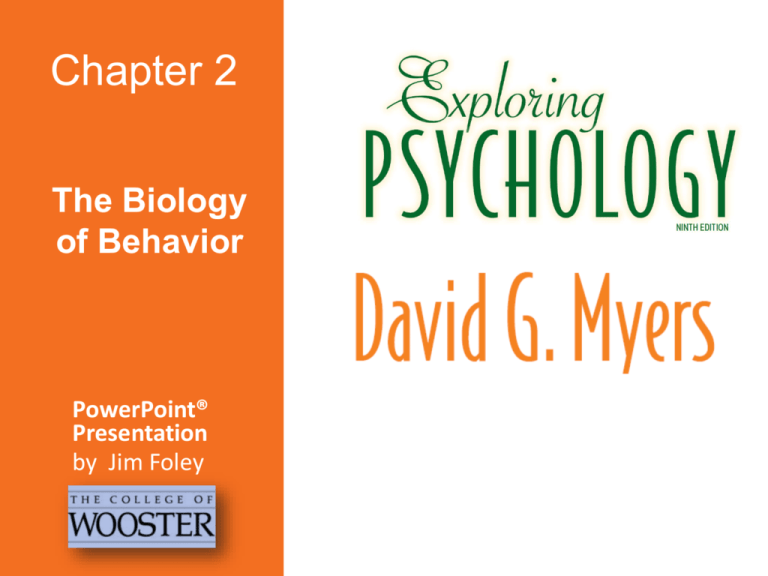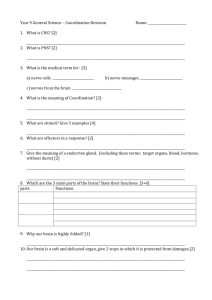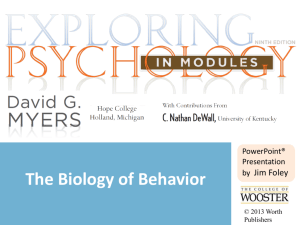
Chapter 2
The Biology
of Behavior
PowerPoint®
Presentation
by Jim Foley
Homework this Weekend
Read pp.56-58
Complete questions on p.58
MONDAY
BE ON TIME!!
We’re doing a fun experiment.
Searching for
the biology of
“self”
Is our identity in the
heart?
In the brain?
In the whole body?
Biological
Psychologists
explore the
associations
between body,
mind, and behavior.
3
Overview: What We Have in Mind
Building blocks of mind: Neurons and how they
communicate (neurotransmitters)
Systems that build the mind: Functions of Parts of
the Nervous system
Supporting player: the slower-communicating
Endocrine system (hormones)
Tools for examining the brain and its activities
More primitive and advanced brain structures
Neural and Hormonal Systems
Neurons and Neuronal Communication:
The Structure of a Neuron
There are billions of neurons
(nerve cells) throughout the body.
Action potential:
a neural impulse that travels down an
axon like a wave
Just as “the wave” can flow to
the right in a stadium even
though the people only move
up and down, a wave moves
down an axon although it is
only made up of ion exchanges
moving in and out.
When does the cell send the action
potential? When it reaches a threshold.
How neurons communicate
(with each other):
The
neuron
receives
signals
from other
neurons;
some are
telling it to
fire and
some are
telling it
not to fire.
• When the
threshold is
reached, the
action potential
starts moving.
• Like a gun, it
either fires or it
doesn’t; more
stimulation does
nothing.
• This is known as
the “all-ornone” response.
The threshold is reached when
excitatory (“Fire!”) signals
outweigh the inhibitory (“Don’t
fire!”) signals by a certain amount.
The
action
potential
travels
down the
axon
from the
cell body
to the
terminal
branches
.
The signal is
transmitted to
another cell.
However, the
message must
find a way to
cross a gap
between cells.
This gap is
also called the
synapse.
The Synapse
The synapse is a
junction between the
axon tip of the
sending neuron and
the dendrite or cell
body of the receiving
neuron.
The synapse is
also known as the
“synaptic
junction” or
“synaptic gap.”
Neural Communication:
Between Neurons
WILEY
VIDEO
© 2012 John Wiley & Sons, Inc.
All rights reserved.
Watchin
g Live
ANIMATION
Neurotrans
-mitters
Neurotransmitters
Neurotransmitters are
chemicals used to send
a signal across the
synaptic gap.
Reuptake:
Recycling Neurotransmitters [NTs]
Reuptake:
After the neurotransmitters
stimulate the receptors on
the receiving neuron, the
chemicals are taken back
up into the sending neuron
to be used again.
Neural Communication:
Between Neurons
© 2012 John Wiley & Sons, Inc.
All rights reserved.
Neural Communication:
Seeing all the Steps Together
Roles of Different Neurotransmitters
Some Neurotransmitters and Their Functions
Neurotransmitter Function
Problems Caused by Imbalances
Serotonin
Affects mood, hunger,
sleep, and arousal
Dopamine
Influences movement,
learning, attention, and
emotion
Undersupply linked to depression;
some antidepressant drugs raise
serotonin levels
Oversupply linked to schizophrenia;
undersupply linked to tremors and
decreased mobility in Parkinson’s
disease and ADHD
Norepinephrine
Enables muscle action,
learning, and memory
Helps control alertness
and arousal
ACh-producing neurons deteriorate as
Alzheimer’s disease progresses
Undersupply can depress mood and
cause ADHD-like attention problems
GABA gammaaminobutyric acid
A major inhibitory
neurotransmitter
Glutamate
A major excitatory
neurotransmitter;
involved in memory
Undersupply linked to seizures,
tremors, and insomnia
Oversupply can overstimulate the brain,
producing migraines or seizures; this is
why some people avoid MSG
(monosodium glutamate) in food
Acetylcholine
(ACh)
Serotonin
pathways
Networks of neurons that
communicate with serotonin
help regulate mood.
Dopamine
pathways
Networks of neurons that
communicate with dopamine are
involved in focusing attention
and controlling movement.
Divisions of the Nervous System
The Inner and Outer Parts of the
Nervous System
The Central
Nervous
System (CNS),
the brain and
spinal cord, is
the body’s
decisionmaker.
The Peripheral
Nervous
System (PNS),
gathers
information
from the body
and sends CNS
decisions out to
the body.
Types of Neurons
_____________
Sensory
Neurons
_____________
carry messages
IN from the
body’s tissues
and sensory
receptors to the
CNS for
processing.
Motor neurons
____________
carry
instructions
OUT from the
Interneurons
CNS out to the _____________
(in the brain
body’s tissues.
and spinal cord)
process
information
between the
sensory input
and motor
output.
The Peripheral Nervous System
The
Autonomic
Nervous
System:
The sympathetic
arouses
NS _________
(fight-or-flight)
The
parasympathetic
calms
NS ________
(rest and digest)
Neural Networks
These complex webs of interconnected neurons form with
experience.
Neurons that fire together, wire together
Remember: “__________________________________.”
Interneurons in the Spine
Decisions
without
______________
made ___________
the brain
Your spine’s interneurons
trigger your hand to pull
away from a fire before
you can say OUCH!
Sensory neuron
This is an example of a
________________.
reflex action
Motor neuron
The brain finds out
about the reflex ____
after it
happens.
The Endocrine System
The
endocrine
system:
a set of
glands that
produce
chemical
messengers
called
hormones.
The Body’s “Slow but Sure”
Endocrine Message System
The endocrine system sends
messages just like the
molecules as ________,
nervous system, but it sends them
Pituitary
through the bloodstream instead of
____________________
gland
across synapses.
hormones
These molecules, called _________,
are produced in various glands
around the body.
The messages go to the brain and
other tissues.
pituitary gland is the “master gland” of the endocrine
The _______________
system.
It is controlled through the nervous system by the nearby brain
area--the hypothalamus.
The pituitary gland produces hormones that regulate other
glands.
Tools of Discovery
and Brain Structures
What We’ll See:
How we learn about
the brain:
Scans and more
The primitive, lifesustaining, inner parts
of the brain:
The _________
brainstem and
limbic system
______
Higher Brain structure
that help us think and
act:
Cerebral Cortex
The _____________
Monitoring activity in the brain
Tools to read electrical, metabolic, and magnetic
activity in the brain:
EEG:
electroencephalogram
PET: positron emission
tomography
MRI: magnetic
resonance imaging
fMRI: functional MRI
EEG:
electroencephalogram
An EEG (electroencephalogram)
is a recording of the __________
Electrical
waves
__________
sweeping across the
brain’s surface.
An EEG is useful in studying
seizures and sleep.
28
PET: positron emission
tomography
The PET scan allows us to see
what part of the brain is active by
________________________
tracing where a radioactive form
of glucose goes while the brain
performs a given task.
MRI: magnetic
resonance imaging
MRI (magnetic resonance imaging)
makes images
_____________from
signals produced
by brain tissue after magnets align the
spin of atoms.
The arrows below show ventricular
enlargement in a schizophrenic patient
(right).
fMRI: functional MRI
Functional MRI reveals
brain activity and
function rather than
structures.
Functional MRI
compares successive
__________________
MRI images taken a
split second apart, and
shows changes in the
level of oxygen in
bloodflow in the brain.
30
The Brain:
Less Complex Brain Structures
Our tour of the brain begins with parts of the human
brain found also in simpler animals; these parts
generally deal with less complex functions:
Brainstem (Pons and Medulla)
Thalamus
Reticular Formation
Cerebellum
Limbic System
The Brainstem:
Pons and Medulla
The Base of the
Brainstem:
The Medulla
The medulla controls the most
heartbeat and
basic functions such as __________
_____________
breathing
_____________.
Someone with total brain damage above the
medulla could still breathe independently, but
someone with damage in this area could not.
The Thalamus
The
crossover
The thalamus is the
“sensory switchboard” or
“________”:
All sensory
router
messages, except smell, are
routed through the
thalamus on the way to the
cortex (outer brain).
over
These messages cross
_________
from one side of the body
to the opposite side of the
brain.
Reticular (“net-like”) Formation
The reticular formation is a
nerve network in the
brainstem.
It enables alertness
(arousal); stimulating this
makes us wide awake.
It also filters incoming
sensory information and
relays it to other brain
areas.
Cerebellum (“little brain”)
The cerebellum
helps
coordinate voluntary
_______________
_______________
movement
such as playing a
sport.
The cerebellum has many other
functions, including enabling
nonverbal learning and memory.
The Limbic (“Border”) System
The limbic system coordinates:
emotions such as fear and
aggression.
basic drives such as hunger and
sex.
the formation of episodic
memories.
The hippocampus (“seahorse”)
processes conscious, episodic
memories.
works with the amygdala to
form emotionally charged
memories.
The Amygdala (“almond”)
consists of two lima bean- sized
neural clusters.
helps process emotions,
especially fear and aggression.
The Amygdala:
Enabling two different responses to threat
Electrical stimulation
of one area of a cat’s
amygdala provokes
aggressive reactions.
If you stimulate a
different part of the
amygdala and put the
cat in a cage with a
mouse, the cat will
cower in terror.
In what region would damage most likely:
1. Disrupt your ability to skip?
2. Disrupt your ability to hear and taste?
3. Perhaps leave you in a coma?
4. Cut off your breath and heartbeat?
Cerebellum
The Hypothalamus:
lies below (“hypo”) the thalamus.
regulates body temperature and
ensures adequate food and water
intake (homeostasis), and is
involved in sex drive.
directs the endocrine system via
messages to the pituitary gland.
Thalamus
The Hypothalamus as a Reward Center
Riddle: Why did the rat
cross the grid?
Why did the rat want to
get to the other side?
Pushing the pedal that
stimulated the electrode
placed in the
hypothalamus was much
more rewarding than food
pellets.








